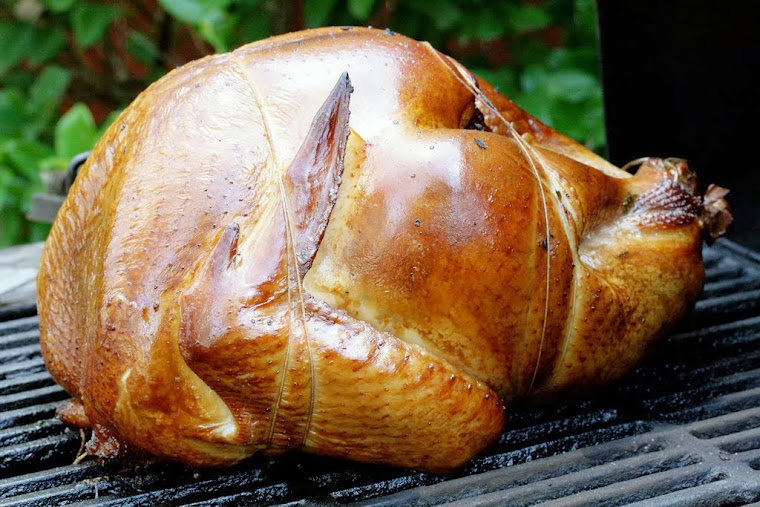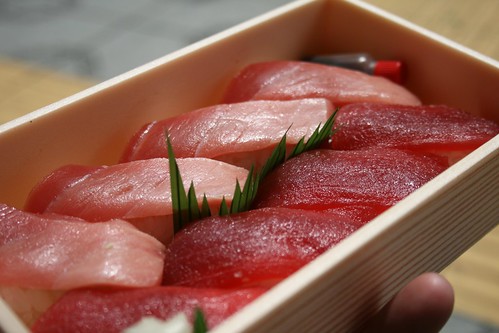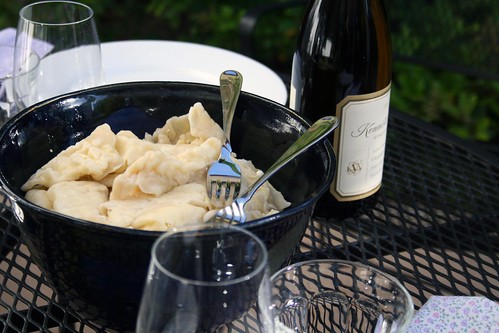
30 June 2010
29 June 2010
Shopping for knives in Tokyo
I was very lucky to spend some time in Korea recently (eating and drinking - and working). On the way back, I returned via Tokyo, and decided to spend a couple days there. Tokyo is quite a playground for someone who enjoys cooking or eating (or both). Sushi. Dumplings. Sake. I had a good time in Tokyo. But my best time, by far, was shopping for knives.
The lovely folks at eGullet pointed me towards Yoshizawa Riko in the Shibuya neighborhood. This brought me here:

I recognized the pale green sign immediately from their website. Who says you have to be able to read to get around Tokyo? As an illiterate buffoon who could only say "Arigatō", I was still able, with hand signals and a smile, to get the shopkeeper to bring out the knives. His Shigefusa sushi knives:

His Shigefusa fish knives:
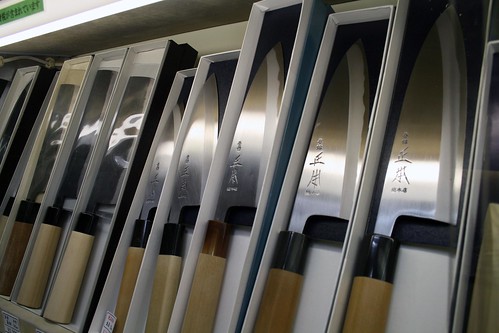
As much as I wanted to bring these home, I didn't. I really, really wanted to bring one home. But I just don't do much fish slicing, and generally cook fish in the shape that I bring it home. I just don't have a need for those knives. Instead, I brought home a Sugimoto gyuto (meat or all-purpose knife):

While the gyuto is often considered a "Western-style" knife, this knife (like many Japanese knives) is sharpened mostly on one side of the blade. It is almost flat on the other side, which allows ridiculously thin slicing. Sharpening on one side also renders the blade right or left-handed, depending on how it is sharpened. But look at how thin I was able to slice that sopressata (from Knight Salumi, incidentally). That was with almost no practice. With a little practice, I think I can beat that.
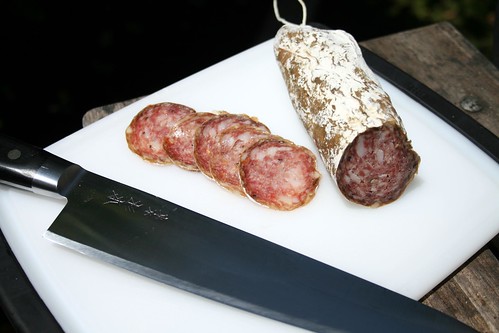
I also brought home a non-stainless steel Shigefusa handmade Tokyo-style Nakiri bocho (vegetable knife). This knife is sharpened on both sides:
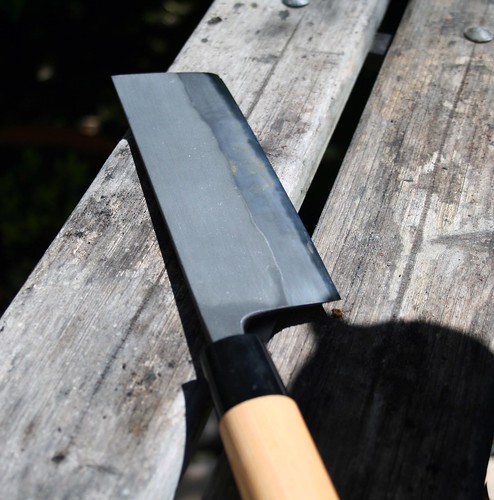
I'd heard that you need to clean these things immediately after using to keep them from staining, and I've already learned how true that is. Those stains near the sharp edge are from sitting on the counter for literally 2 minutes after chopping an onion while I looked for a clean cloth.
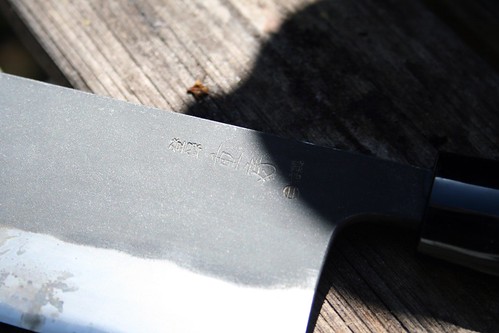
An amazing knife, but keep a cloth nearby for cleanup.
I'm loving playing with these guys in the kitchen. What remains to be seen - can I find someone in San Diego who knows how to properly sharpen Japanese knives?
The lovely folks at eGullet pointed me towards Yoshizawa Riko in the Shibuya neighborhood. This brought me here:

I recognized the pale green sign immediately from their website. Who says you have to be able to read to get around Tokyo? As an illiterate buffoon who could only say "Arigatō", I was still able, with hand signals and a smile, to get the shopkeeper to bring out the knives. His Shigefusa sushi knives:

His Shigefusa fish knives:

As much as I wanted to bring these home, I didn't. I really, really wanted to bring one home. But I just don't do much fish slicing, and generally cook fish in the shape that I bring it home. I just don't have a need for those knives. Instead, I brought home a Sugimoto gyuto (meat or all-purpose knife):

While the gyuto is often considered a "Western-style" knife, this knife (like many Japanese knives) is sharpened mostly on one side of the blade. It is almost flat on the other side, which allows ridiculously thin slicing. Sharpening on one side also renders the blade right or left-handed, depending on how it is sharpened. But look at how thin I was able to slice that sopressata (from Knight Salumi, incidentally). That was with almost no practice. With a little practice, I think I can beat that.

I also brought home a non-stainless steel Shigefusa handmade Tokyo-style Nakiri bocho (vegetable knife). This knife is sharpened on both sides:

I'd heard that you need to clean these things immediately after using to keep them from staining, and I've already learned how true that is. Those stains near the sharp edge are from sitting on the counter for literally 2 minutes after chopping an onion while I looked for a clean cloth.

An amazing knife, but keep a cloth nearby for cleanup.
I'm loving playing with these guys in the kitchen. What remains to be seen - can I find someone in San Diego who knows how to properly sharpen Japanese knives?
Keywords:
kitchen toys
24 June 2010
Grilled bok choy
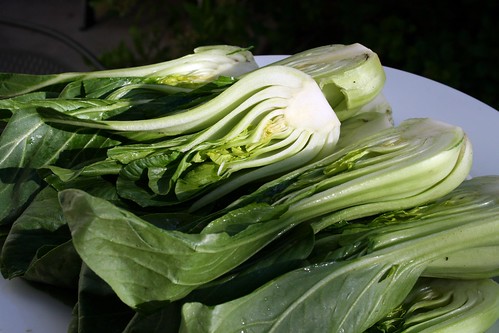
Lest you think that all we eat here at Indirect Heat is meat, meat and more meat, I show you a quick veggie that we like to toss on the grill.
Wash the bok choy, and slice in half lengthwise. Brush the open side with olive oil. Immediately after you pull the meat off the grill to rest, arrange the bok choy, open side down on the grill.
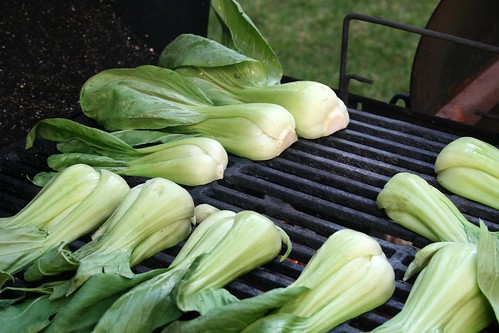
Place the base of the bok choy over direct heat, with the leaves as far from the heat as possible (they will burn and disintegrate rather quickly if they are over direct heat). The base of the bok choy is quite crisp, and requires a few minutes to break down.
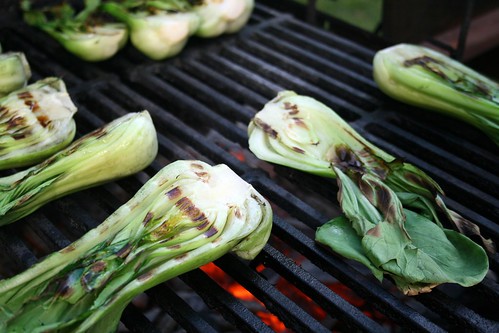
Remove from heat after the bok choy are softened nicely. (Sometimes the very tip of the stem doesn't soften before the leaves start to burn - in that case, we remove it and eat everything except the tip).
Sprinkle with kosher salt, and serve immediately. Crisp, fresh and delicious.
Keywords:
direct heat,
side
23 June 2010
22 June 2010
영양탕 - Korean dog soup
I was fortunate to have work send me to Korea recently. I wish I had had time to take more pictures of the many tasty things that came across my plate while I was there. But I couldn't give up the chance to try a Korean dish famous the world over - Bosintang. Korean dog meat soup.
I don't speak Korean, so finding such a place was challenging. Though illegal on the mainland, on Jeju Island (where I was staying), dogmeat is legal. I approached the English-speaking concierge in my hotel, and asked:
"Can you recommend a restaurant where I can try dog?"
"What for?" She looked aghast.
"I'd like to try dog meat."
"What?!?"
At this point, I was concerned. Had I been had? I had been told dogmeat was reasonably common in Korea, but given her reaction, I was a tad concerned that I had been misinformed.
She paused. "Foreigners *never* ask for dogmeat." She paused again. "One of my coworkers really likes dog. I'll call him to find out where the best place is."
She spent some time on the phone and returned. She wrote out 3 notes in Korean, one was instructions for the cabbie for where to go. One was a note for the restaurant, telling them what I wanted. The final note was for the cabbie to help me return.
"I've tried dog soup." she said. "The meat smells bad."
"Hmmm." I said. "I'd like to try it."
"You're very brave."
I don't know about that last part, but I'm certainly curious - and when will I have a chance to try this again? I don't expect to be in Korea often, if ever again. So this was my chance. And off I went.
The restaurant I found was very small, on a narrow side street. I took pictures of the sign and the menu so I could later confirm that I had, indeed, eaten at the right place.

Inside, there was a raised area with low tables, and a bunch of shoes near the entrance. I removed my shoes, and followed the waiter in to sit at a low table.

I showed the waiter my note, and he pointed to the sign on the wall, so he could indicate the price. The dog soup is the third one down on the left. 8000 Korean won (₩) - or about $8.

My Korean colleagues confirmed that this was the right dish. The characters:
영양탕
translate to:
yeongyangtang or "nutritious soup", one of many euphemisms for dog soup listed on the Wikipedia. This is when the only word of English passed from my waiter's mouth. "Beeruh?"
Yes, yes I think having a beer during this excursion was more than appropriate, and indeed all of the other tables were also consuming beer with their soup. The beer was a brand I had not seen before, labeled in English as "Cass Fresh".
As with many Korean meals, they loaded the table up with many condiments. Naturally, there was kimchi, the fermented, spiced cabbage dish.
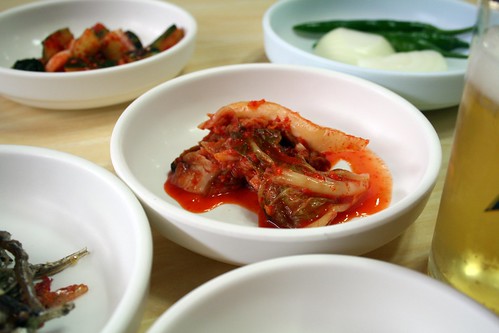
A spiced cucumber/zucchini like critter.

Dried, salted anchovies. These were excellent, if a little spiky. They poke into your mouth in a rather unpleasant way when chewing them. I think they'd be quite nice if gently stewed (though that might take out some of the nice saltiness).
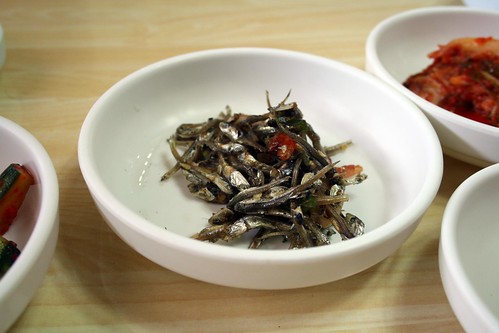
Red dragon sauce? Maybe.

And a small bowl with what looked like serrano peppers with onion slices.
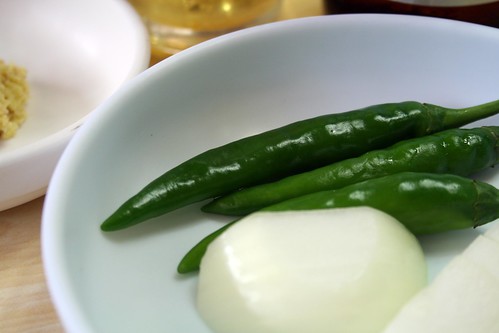
I sat alone with these dishes, nursing my beer, and trying pretty hard to ignore the older Korean gentleman at the table next to me that were staring at me. Clearly, they were as surprised as the concierge, to see a 6' 3" white guy, about to dine on dog.
After about 15 minutes, an older woman emerged, carrying a screaming hot ceramic pot. She scowled at me, as she set it in front of me. It was boiling vigorously as she set in front of me. And it smelled heavenly.
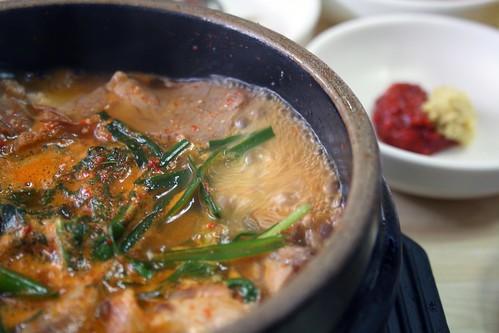
Look at that!

The broth was a bright, spicy flavour. I had assumed there was tomato in there from the colour, but there was no tomato flavour. Rich, bright and quite spicy. The greens were pretty sturdy, but quite delicious, (and I always enjoy discovering new greens). This is a very hearty soup. But you haven't read this far to hear about the broth...
I hate when people compare one meat to another. "It's like chicken." No it's not. Duck is not like chicken. Turkey is not like chicken. But if you are going to explain what a meat is like, I suppose the easiest way to do it is to compare it to meats people know.
Dog meat is *extremely* fatty. Not quite as fatty as pork belly, but close. And the texture of the meat is very beeflike. The cuts reminded me of cuts of brisket. But the flavour was more like mutton or lamb. Very gamy, but not unpleasantly so. The first few bites of meat, I put the whole thing in my mouth, but I very quickly found the fat off-putting, and pulled the large chunks of fat off.

I later read that Koreans prize the fat and the skin. I confess, I didn't. The meat was really flavourful, and really nice, but the fat was too much for my Canadian palate.
I really liked this soup, and found myself wondering how well dog would stand up on the barbecue, with the fat properly rendered (this is how my mind works, I'm afraid).
I'm glad I went out to try this soup, but I was embarrassed when I left that I didn't finish it. They brought me an enormous bowl, and I simply couldn't finish it. I finished the meat (though not the fat) - I think it's near a sin to waste meat. But I left a fair amount of broth and greens on the bottom of my bowl. I looked over, and was relieved to see that some of the other folks in the restaurant also were leaving some food in their bowl.
This wasn't the best meal I had in Korea, but it was by far the most memorable.
I don't speak Korean, so finding such a place was challenging. Though illegal on the mainland, on Jeju Island (where I was staying), dogmeat is legal. I approached the English-speaking concierge in my hotel, and asked:
"Can you recommend a restaurant where I can try dog?"
"What for?" She looked aghast.
"I'd like to try dog meat."
"What?!?"
At this point, I was concerned. Had I been had? I had been told dogmeat was reasonably common in Korea, but given her reaction, I was a tad concerned that I had been misinformed.
She paused. "Foreigners *never* ask for dogmeat." She paused again. "One of my coworkers really likes dog. I'll call him to find out where the best place is."
She spent some time on the phone and returned. She wrote out 3 notes in Korean, one was instructions for the cabbie for where to go. One was a note for the restaurant, telling them what I wanted. The final note was for the cabbie to help me return.
"I've tried dog soup." she said. "The meat smells bad."
"Hmmm." I said. "I'd like to try it."
"You're very brave."
I don't know about that last part, but I'm certainly curious - and when will I have a chance to try this again? I don't expect to be in Korea often, if ever again. So this was my chance. And off I went.
The restaurant I found was very small, on a narrow side street. I took pictures of the sign and the menu so I could later confirm that I had, indeed, eaten at the right place.

Inside, there was a raised area with low tables, and a bunch of shoes near the entrance. I removed my shoes, and followed the waiter in to sit at a low table.

I showed the waiter my note, and he pointed to the sign on the wall, so he could indicate the price. The dog soup is the third one down on the left. 8000 Korean won (₩) - or about $8.

My Korean colleagues confirmed that this was the right dish. The characters:
영양탕
translate to:
yeongyangtang or "nutritious soup", one of many euphemisms for dog soup listed on the Wikipedia. This is when the only word of English passed from my waiter's mouth. "Beeruh?"
Yes, yes I think having a beer during this excursion was more than appropriate, and indeed all of the other tables were also consuming beer with their soup. The beer was a brand I had not seen before, labeled in English as "Cass Fresh".
As with many Korean meals, they loaded the table up with many condiments. Naturally, there was kimchi, the fermented, spiced cabbage dish.

A spiced cucumber/zucchini like critter.

Dried, salted anchovies. These were excellent, if a little spiky. They poke into your mouth in a rather unpleasant way when chewing them. I think they'd be quite nice if gently stewed (though that might take out some of the nice saltiness).

Red dragon sauce? Maybe.

And a small bowl with what looked like serrano peppers with onion slices.

I sat alone with these dishes, nursing my beer, and trying pretty hard to ignore the older Korean gentleman at the table next to me that were staring at me. Clearly, they were as surprised as the concierge, to see a 6' 3" white guy, about to dine on dog.
After about 15 minutes, an older woman emerged, carrying a screaming hot ceramic pot. She scowled at me, as she set it in front of me. It was boiling vigorously as she set in front of me. And it smelled heavenly.

Look at that!

The broth was a bright, spicy flavour. I had assumed there was tomato in there from the colour, but there was no tomato flavour. Rich, bright and quite spicy. The greens were pretty sturdy, but quite delicious, (and I always enjoy discovering new greens). This is a very hearty soup. But you haven't read this far to hear about the broth...
I hate when people compare one meat to another. "It's like chicken." No it's not. Duck is not like chicken. Turkey is not like chicken. But if you are going to explain what a meat is like, I suppose the easiest way to do it is to compare it to meats people know.
Dog meat is *extremely* fatty. Not quite as fatty as pork belly, but close. And the texture of the meat is very beeflike. The cuts reminded me of cuts of brisket. But the flavour was more like mutton or lamb. Very gamy, but not unpleasantly so. The first few bites of meat, I put the whole thing in my mouth, but I very quickly found the fat off-putting, and pulled the large chunks of fat off.

I later read that Koreans prize the fat and the skin. I confess, I didn't. The meat was really flavourful, and really nice, but the fat was too much for my Canadian palate.
I really liked this soup, and found myself wondering how well dog would stand up on the barbecue, with the fat properly rendered (this is how my mind works, I'm afraid).
I'm glad I went out to try this soup, but I was embarrassed when I left that I didn't finish it. They brought me an enormous bowl, and I simply couldn't finish it. I finished the meat (though not the fat) - I think it's near a sin to waste meat. But I left a fair amount of broth and greens on the bottom of my bowl. I looked over, and was relieved to see that some of the other folks in the restaurant also were leaving some food in their bowl.
This wasn't the best meal I had in Korea, but it was by far the most memorable.
Keywords:
restaurant,
travel
17 June 2010
Pomegranate buttermilk panna cotta
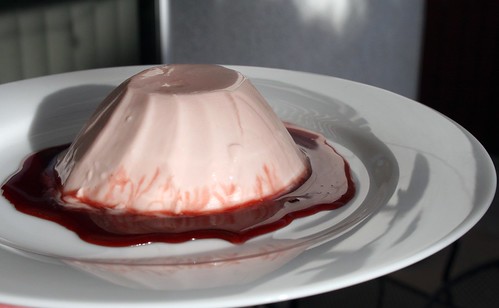
So I've got this huge case of free pomegranate juice, and I really need to find a good use for it soon. It's pasteurized, not sterilized, so it needs to be refrigerated, and has a limited shelf life. (As a recap: I've been bought. The lovely folks at Pomwonderful have given me a case of free pomegranate juice, and I've been playing with it. It's tasty).
Alright, so I thought a lovely pomegranate panna cotta would hit the spot, so I tweaked a panna cotta recipe that I've used several times in the past:
1 ¼ cup pomegranate juiceMix the pomegranate juice and buttermilk. Run through a blender until smooth. Meanwhile, mix the gelatin in the water, and leave to hydrate. Heat the cream and sugar over medium heat until the sugar dissolves.
1 ¼ cups well-shaken buttermilk
2 ¾ teaspoons unflavored gelatin (from two ¼-oz envelopes)
¼ cup water
1 ½ cups heavy cream
⅔ cup sugar
Take the cream off the heat, and add the hydrated gelatin. Stir until it dissolves completely. This is the only tricky part, you want to make sure there are no little granules of gelatin in there, as that will make the final texture less than awesome. And this dessert deserves to be awesome. If the gelatin won't go into solution, heat the cream gently over low heat, stirring, until the gelatin dissolves.
Immediately remove from the heat, and pour into molds. Cover and chill for at least six hours.
Shortly before serving, make the sauce.
½ cup cassisMix all of the ingredients, boil for ten minutes, or until it reduces into a syrup. Remove from heat.
½ cup pomegranate juice
1 tbsp sugar
1 pinch cinnamon
juice of 1 lime
I really need to get photos of this next segment, but it tends to happen too fast to get photos. Run a knife around the outside of the panna cotta, to loosen the edge from the mold. Then briefly set the base of the panna cotta in a bowl of hot water, to melt the gelatin at the bottom of the mold. Lift out the mold, and place your serving plate over top of the mold. Invert the mold. Shake the mold gently to loosen it from the mold, onto the plate.
Drizzle sauce around the panna cotta. Repeat with the other panna cottas, serving one for each guest.

Enjoy. This panna cotta was a hit. Perfect consistency, fruity, and the sauce brings a nice hit of acid to the dish. Wonderful, serve this one today.
Keywords:
dessert
15 June 2010
Korean rice beverage
In Korea, I discovered some interesting things in the vending machine. First, it appears Jolt Cola's Gatorade's campaign of world domination has been successful:

Second, Koreans have all kinds of exciting beverages. Try this one, canned sikhye, according to Dr. Ricky:
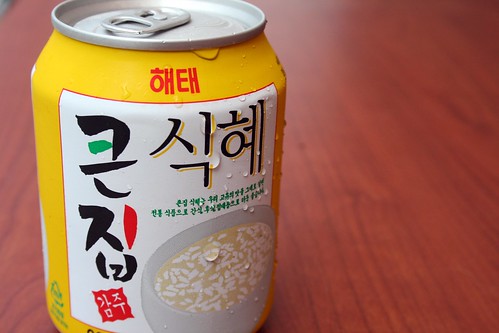
Mild flavoured, it tastes a lot like Thai sticky rice. One would assume, then, that it is sweetened with palm sugar. It's a lot less sweet than many American vending machine beverages. It's really quite tasty. Not something to relieve the heat and humidity of a June day in Korea, but it really is quite nice.
It might take me a while to get used to the chunks on bottom, though.
Oh, and it's 116,000 calories.
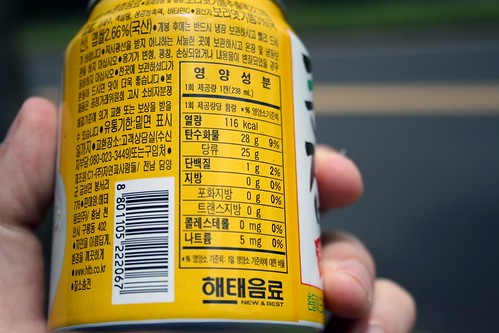
Yum.

Second, Koreans have all kinds of exciting beverages. Try this one, canned sikhye, according to Dr. Ricky:

Mild flavoured, it tastes a lot like Thai sticky rice. One would assume, then, that it is sweetened with palm sugar. It's a lot less sweet than many American vending machine beverages. It's really quite tasty. Not something to relieve the heat and humidity of a June day in Korea, but it really is quite nice.
It might take me a while to get used to the chunks on bottom, though.
Oh, and it's 116,000 calories.

Yum.
Keywords:
travel
10 June 2010
Grilled cauliflower
I talk about meat alot here. That's not to say we don't eat our veggies, but we often serve vegetables pretty simply. Take cauliflower. Break it into florets. Boil for 2 minutes. Immediately plunge into cold water.
Toss on the grill while your meat is resting. Brown the outside, and serve.
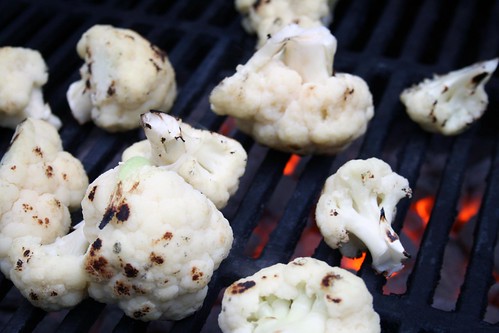
Toss on the grill while your meat is resting. Brown the outside, and serve.

Keywords:
direct heat,
side
09 June 2010
08 June 2010
Bbq sushi
So Mrs. Dude and I had a weekend alone in Los Angeles recently. (Bbq Jr. was home with Grandma Dude). And of course, we have to check out the local restaurant scene. First night up? Kiriko Sushi. We were a little concerned when we found the place. It's in a dying conference/banquet center, where half the businesses are empty, and from the ground floor, it looks like Kiriko will be seeing the grim reaper soon. But when you walk in, it's hopping inside.
This is one of those sushi joints where you sit down at the bar, and the conveyer belt in front of you brings fresh sushi by. You grab a roll, or a piece of sushi, and eat it, and at the end of the meal they count the number and colour of the plates in front of you, and tabulate your bill. I've only been to such a place once before, and it wasn't that good. You can imagine, if not properly done, the sushi can age on the belt. It's not conducive to making the freshest product.
At Kiriko, even at 6:30 p.m., the place was hopping, and food was moving off and onto the belt at a pretty decent clip. Everything was fresh and delicious. The various deep-fried offerings were still warm, and so delicately seasoned. Even the spicy tuna roll, often used as a way to hide old tuna, was sweet and delicate.
This was an enjoyable meal, and we stuffed ourselves silly. (Yes, we got a bit out of hand. It's been quite some time since we had sushi that compared favourably to Kiriko).
Just when I thought I was done, I see the sushi-maestro going all Pulp Fiction on a piece of halibut with a blowtorch. Awesome. Bbq sushi. Well, you just know I had to try it. It was a basically a California roll, wrapped with caramelized halibut, with a wee bit of Kirik Secret Sauce, also caramelized. It tasted of smoke and fish and rice and sauce and YUM! The perfect way to end the meal.
If you find yourself in L.A., and are looking for a place to have excellent sushi, keep Kiriko on your list.
View Larger Map
This is one of those sushi joints where you sit down at the bar, and the conveyer belt in front of you brings fresh sushi by. You grab a roll, or a piece of sushi, and eat it, and at the end of the meal they count the number and colour of the plates in front of you, and tabulate your bill. I've only been to such a place once before, and it wasn't that good. You can imagine, if not properly done, the sushi can age on the belt. It's not conducive to making the freshest product.
At Kiriko, even at 6:30 p.m., the place was hopping, and food was moving off and onto the belt at a pretty decent clip. Everything was fresh and delicious. The various deep-fried offerings were still warm, and so delicately seasoned. Even the spicy tuna roll, often used as a way to hide old tuna, was sweet and delicate.
This was an enjoyable meal, and we stuffed ourselves silly. (Yes, we got a bit out of hand. It's been quite some time since we had sushi that compared favourably to Kiriko).
Just when I thought I was done, I see the sushi-maestro going all Pulp Fiction on a piece of halibut with a blowtorch. Awesome. Bbq sushi. Well, you just know I had to try it. It was a basically a California roll, wrapped with caramelized halibut, with a wee bit of Kirik Secret Sauce, also caramelized. It tasted of smoke and fish and rice and sauce and YUM! The perfect way to end the meal.
If you find yourself in L.A., and are looking for a place to have excellent sushi, keep Kiriko on your list.
View Larger Map
Keywords:
restaurant
03 June 2010
Fleur de sel caramels

What's a tasty dessert that you can serve after dessert? (Yeah, baby, let's have a 2 dessert dinner! That's decadence!)
Caramels. And, they don't take much time. I used the recipe from Gourmet. (Back before they sucked. Naturally, before they were shut down.)
1 cup heavy creamLine an 8 × 8 pan with parchment paper. Oil the paper lightly.
5 tablespoons unsalted butter, cut into pieces
1 teaspoon fleur de sel (+ extra for sprinkling)
1 ½ cups sugar
¼ cup light corn syrup
¼ cup water
Warm the cream, butter and fleur de sel in a small heavy saucepan. Bring them to a boil, stirring. Keep warm.
Meanwhile, mix the water, corn syrup and sugar in a heavy pot.

Heat over medium heat, stirring until sugar dissolves.
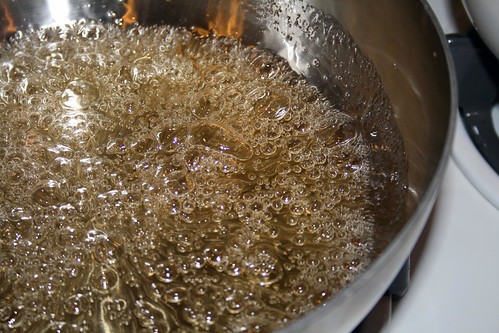
Keep warm, swirling the pan to mix periodically. This next bit will take a while, but once the colour change starts, it will happen quickly. The colour change indicates that the sugar is caramelizing, and taking on really delicious flavours.

Once it reaches a nice deep brown colour, pour in the warm cream mixture. BE CAREFUL. The foaming and popping is rather exciting.
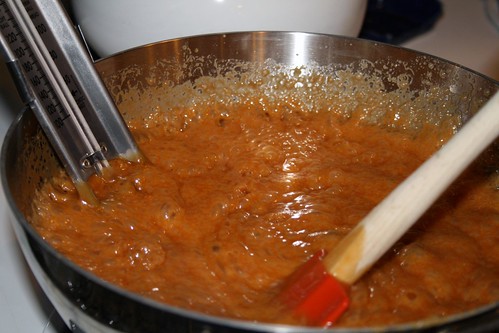
Continue stirring over medium heat. When the caramel reaches 248°F, pour it into the parchment lined pan. Let cool two hours.
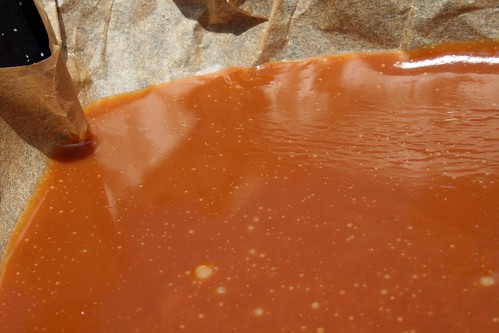
Remove the caramel. Slice it in two, and roll it lengthwise.
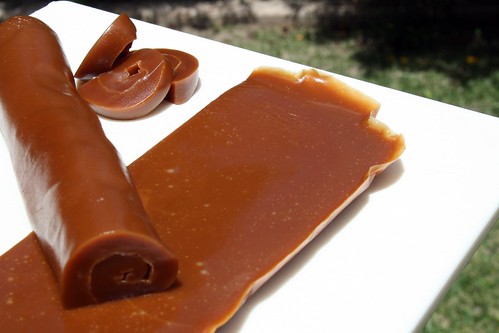
Slice the rolled caramel into individual pieces. Serve in a manner that they're not touching each other, as they can incredibly sticky. Sprinkle with remaining fleur de sel on the caramels (or not).
Serve.

These caramels are soft, gooey, pull-your-fillings-out sticky, but the delicious buttery, caramel flavour is really tasty. These are going to become a traditional favourite in the Dude household. Tasty.
Keywords:
dessert
02 June 2010
01 June 2010
Pomegranate-thyme sorbet
You may recall that I've arrived at the food blogger bigtime. I have. Received. Free juice. Yes, the lovely folks at Pomwonderful have seen fit to promote their product with me. Pomegranate juice. They sent me a case of the stuff, so take anything I say about it with a grain of salt. I have been bought. ;)
But what to do with pomegranate juice that's truly creative or fun? How about a tasty palate cleanser? I decided to make a pomegranate-thyme sorbet. I used this pomegranate sorbet recipe from Cafe Fernando as a starting point for 1 quart of pomegranate-thyme sorbet:

Let steep for two hours, then sieve out the chunks of lemon pulp and thyme leaves out of the syrup. Add 1 oz vodka (vodka keeps the sorbet from freezing too hard, but doesn't add any significant amount of alcohol). Move to the fridge for at least six hours, preferably overnight.
Run through your ice cream maker. With the KitchenAid Ice Cream Maker Attachment , it means turn on your stirrer to the "stir" setting, and then pour in the cold sorbet syrup. Run for 25 minutes until nicely frozen into a sorbet.
, it means turn on your stirrer to the "stir" setting, and then pour in the cold sorbet syrup. Run for 25 minutes until nicely frozen into a sorbet.
For such a strong-flavoured sorbet, I pour the servings into shot glasses, and freeze them harder in the freezer. Otherwise, you can just freeze it in a larger container, and scoop it to serve.
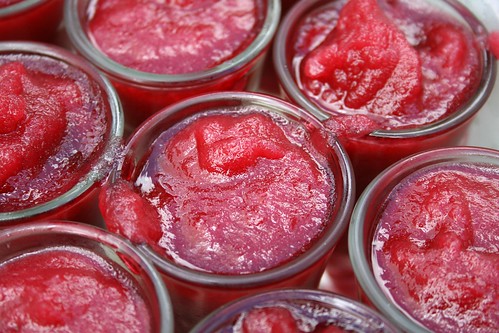
Serve with a long handled spoon, so you can scrape out every drop.
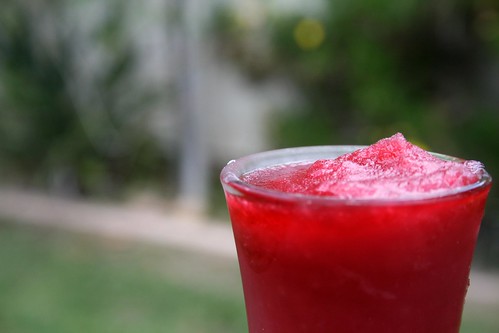
Look at that incredible colour! Yum. The lemon thyme blends really well with the pomegranate, and this is a bright, fruity mix with just enough acid to keep the flavour interesting. Perfect to cut through the grease of a bbq dinner, for example, pulled pork (what I served the pomegranate-thyme sorbet after).
Yum.
Post-script: In the future, it might be fun to substitute the vodka with a flavoured alcohol, like green Chartreuse. These are flavours that go well with the thyme in this recipe, and I think Chartreuse might be tasty with the pomegranate as well...
But what to do with pomegranate juice that's truly creative or fun? How about a tasty palate cleanser? I decided to make a pomegranate-thyme sorbet. I used this pomegranate sorbet recipe from Cafe Fernando as a starting point for 1 quart of pomegranate-thyme sorbet:
4 cups pomegranate juiceCombine everything except the vodka, and heat over medium heat until it boils.
1 ¼ cups sugar
2 tbsp fresh squeezed lemon juice
large bunch of lemon thyme
1 oz vodka

Let steep for two hours, then sieve out the chunks of lemon pulp and thyme leaves out of the syrup. Add 1 oz vodka (vodka keeps the sorbet from freezing too hard, but doesn't add any significant amount of alcohol). Move to the fridge for at least six hours, preferably overnight.
Run through your ice cream maker. With the KitchenAid Ice Cream Maker Attachment
For such a strong-flavoured sorbet, I pour the servings into shot glasses, and freeze them harder in the freezer. Otherwise, you can just freeze it in a larger container, and scoop it to serve.

Serve with a long handled spoon, so you can scrape out every drop.

Look at that incredible colour! Yum. The lemon thyme blends really well with the pomegranate, and this is a bright, fruity mix with just enough acid to keep the flavour interesting. Perfect to cut through the grease of a bbq dinner, for example, pulled pork (what I served the pomegranate-thyme sorbet after).
Yum.
Post-script: In the future, it might be fun to substitute the vodka with a flavoured alcohol, like green Chartreuse. These are flavours that go well with the thyme in this recipe, and I think Chartreuse might be tasty with the pomegranate as well...
Keywords:
dessert,
palate cleanser
Subscribe to:
Posts (Atom)
